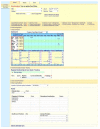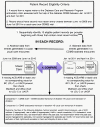Impact of a computerized system for evidence-based diabetes care on completeness of records: a before-after study
- PMID: 22769425
- PMCID: PMC3461491
- DOI: 10.1186/1472-6947-12-63
Impact of a computerized system for evidence-based diabetes care on completeness of records: a before-after study
Abstract
Background: Physicians practicing in ambulatory care are adopting electronic health record (EHR) systems. Governments promote this adoption with financial incentives, some hinged on improvements in care. These systems can improve care but most demonstrations of successful systems come from a few highly computerized academic environments. Those findings may not be generalizable to typical ambulatory settings, where evidence of success is largely anecdotal, with little or no use of rigorous methods. The purpose of our pilot study was to evaluate the impact of a diabetes specific chronic disease management system (CDMS) on recording of information pertinent to guideline-concordant diabetes care and to plan for larger, more conclusive studies.
Methods: Using a before-after study design we analyzed the medical record of approximately 10 patients from each of 3 diabetes specialists (total = 31) who were seen both before and after the implementation of a CDMS. We used a checklist of key clinical data to compare the completeness of information recorded in the CDMS record to both the clinical note sent to the primary care physician based on that same encounter and the clinical note sent to the primary care physician based on the visit that occurred prior to the implementation of the CDMS, accounting for provider effects with Generalized Estimating Equations.
Results: The CDMS record outperformed by a substantial margin dictated notes created for the same encounter. Only 10.1% (95% CI, 7.7% to 12.3%) of the clinically important data were missing from the CDMS chart compared to 25.8% (95% CI, 20.5% to 31.1%) from the clinical note prepared at the time (p < 0.001) and 26.3% (95% CI, 19.5% to 33.0%) from the clinical note prepared before the CDMS was implemented (p < 0.001). There was no significant difference between dictated notes created for the CDMS-assisted encounter and those created for usual care encounters (absolute mean difference, 0.8%; 95% CI, -8.5% to 6.8%).
Conclusions: The CDMS chart captured information important for the management of diabetes more often than dictated notes created with or without its use but we were unable to detect a difference in completeness between notes dictated in CDMS-associated and usual-care encounters. Our sample of patients and providers was small, and completeness of records may not reflect quality of care.
Figures






Similar articles
-
Evaluation of a chronic disease management system for the treatment and management of diabetes in primary health care practices in Ontario: an observational study.Ont Health Technol Assess Ser. 2014 Apr 1;14(3):1-37. eCollection 2014. Ont Health Technol Assess Ser. 2014. PMID: 24748911 Free PMC article.
-
Structured electronic operative reporting: comparison with dictation in kidney cancer surgery.Int J Med Inform. 2012 Mar;81(3):182-91. doi: 10.1016/j.ijmedinf.2011.11.008. Epub 2012 Jan 2. Int J Med Inform. 2012. PMID: 22217801
-
Relationship between documentation method and quality of chronic disease visit notes.Appl Clin Inform. 2014 May 14;5(2):480-90. doi: 10.4338/ACI-2014-01-RA-0007. eCollection 2014. Appl Clin Inform. 2014. PMID: 25024762 Free PMC article.
-
Costs and benefits of health information technology.Evid Rep Technol Assess (Full Rep). 2006 Apr;(132):1-71. doi: 10.23970/ahrqepcerta132. Evid Rep Technol Assess (Full Rep). 2006. PMID: 17627328 Free PMC article. Review.
-
A review of randomized controlled trials of medical record powered clinical decision support system to improve quality of diabetes care.Int J Med Inform. 2016 Mar;87:91-100. doi: 10.1016/j.ijmedinf.2015.12.017. Epub 2015 Dec 30. Int J Med Inform. 2016. PMID: 26806716 Review.
Cited by
-
Computer versus physician identification of gastrointestinal alarm features.Int J Med Inform. 2015 Dec;84(12):1111-7. doi: 10.1016/j.ijmedinf.2015.07.006. Epub 2015 Jul 26. Int J Med Inform. 2015. PMID: 26254875 Free PMC article.
-
A pilot study of the functionality and clinician acceptance of a clinical decision support tool to improve primary care of opioid use disorder.Addict Sci Clin Pract. 2021 Jun 15;16(1):37. doi: 10.1186/s13722-021-00245-7. Addict Sci Clin Pract. 2021. PMID: 34130758 Free PMC article.
-
Mixed Influence of Electronic Health Record Implementation on Diabetes Order Patterns for Michigan Medicaid Adults.J Diabetes Sci Technol. 2015 Aug 20;10(2):429-34. doi: 10.1177/1932296815601689. J Diabetes Sci Technol. 2015. PMID: 26292961 Free PMC article.
-
Filtering data from the collaborative initial glaucoma treatment study for improved identification of glaucoma progression.BMC Med Inform Decis Mak. 2013 Dec 21;13:137. doi: 10.1186/1472-6947-13-137. BMC Med Inform Decis Mak. 2013. PMID: 24359562 Free PMC article.
-
Evaluation of a chronic disease management system for the treatment and management of diabetes in primary health care practices in Ontario: an observational study.Ont Health Technol Assess Ser. 2014 Apr 1;14(3):1-37. eCollection 2014. Ont Health Technol Assess Ser. 2014. PMID: 24748911 Free PMC article.
References
-
- Souza NM, Sebaldt RJ, Mackay JA, Prorok J, Weise-Kelly L, Navarro T, Wilczynski N, Haynes RB. the CCDSS Systematic Review Team. Computerized clinical decision support systems for primary preventive care: a decision-maker–researcher partnership systematic review of effects on process of care and patient outcomes. Implement Sci. 2011;6:87. doi: 10.1186/1748-5908-6-87. - DOI - PMC - PubMed
-
- Roshanov PS, You JJ, Dhaliwal J, Koff D, Mackay JA, Weise-Kelly L, Navarro T, Wilczynski NL, Haynes RB. the CCDSS Systematic Review Team. Can computerized clinical decision support systems improve practitioners’ diagnostic test ordering behavior? A decision-maker–researcher partnership systematic review. Implement Sci. 2011;6:88. doi: 10.1186/1748-5908-6-88. - DOI - PMC - PubMed
-
- Sahota N, Lloyd R, Ramakrishna A, Mackay J, Prorok J, Weise-Kelly L, Navarro T, Wilczynski N, Haynes RB. the CCDSS Systematic Review Team. Computerized clinical decision support systems for acute care management: a decision-maker–researcher partnership systematic review of effects on process of care and patient outcomes. Implement Sci. 2011;6:91. doi: 10.1186/1748-5908-6-91. - DOI - PMC - PubMed
-
- Hemens BJ, Holbrook AM, Tonkin M, Mackay JA, Weise-Kelly L, Navarro T, Wilczynski N, Haynes RB. the CCDSS Systematic Review Team. Computerized clinical decision support systems for drug prescribing and management: a decision-maker–researcher partnership systematic review. Implement Sci. 2011;6:89. doi: 10.1186/1748-5908-6-89. - DOI - PMC - PubMed
-
- Nieuwlaat R, Connolly S, Mackay JA, Weise-Kelly L, Navarro T, Wilczynski NL, Haynes RB. the CCDSS Systematic Review Team. Computerized clinical decision support systems for therapeutic drug monitoring and dosing: a decision-maker–researcher partnership systematic review. Implement Sci. 2011;6:90. doi: 10.1186/1748-5908-6-90. - DOI - PMC - PubMed
Publication types
MeSH terms
Grants and funding
LinkOut - more resources
Full Text Sources
Medical

